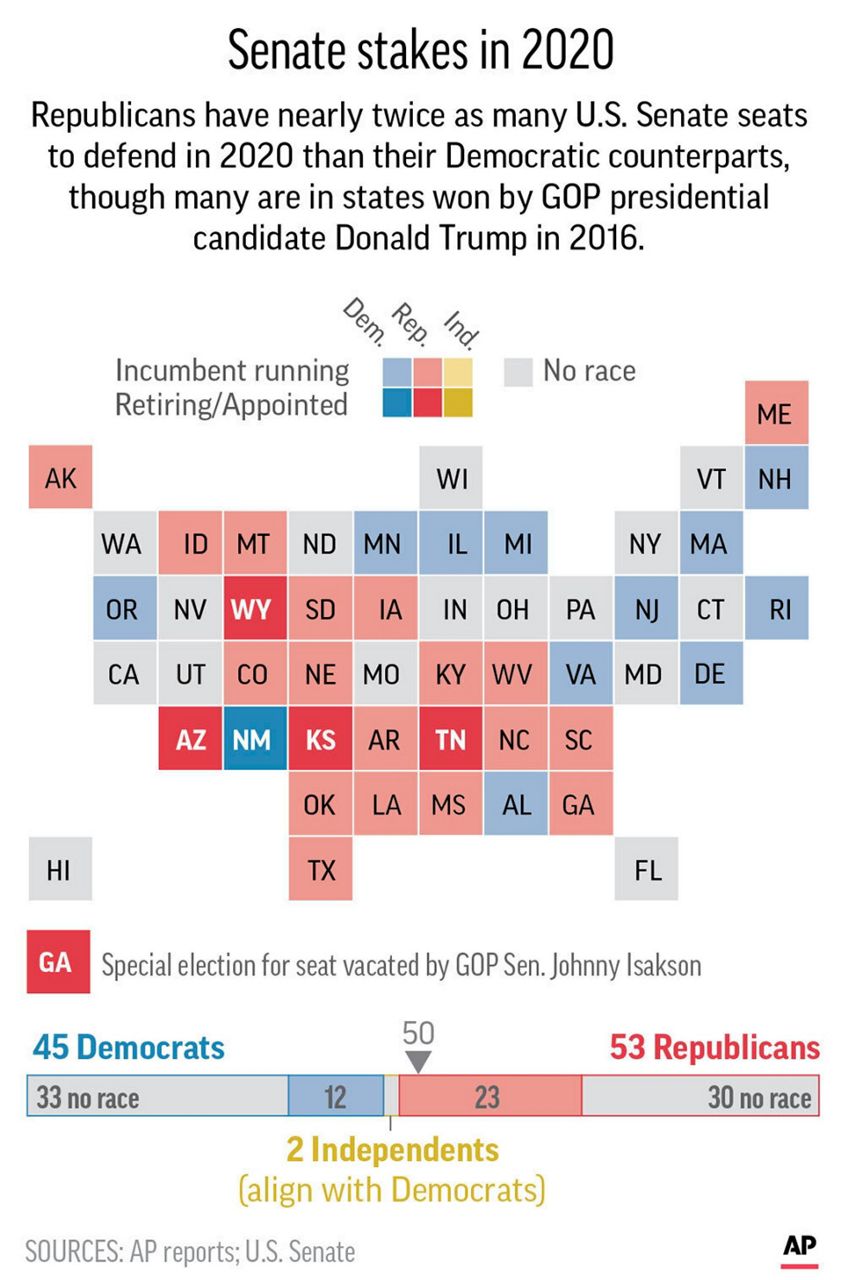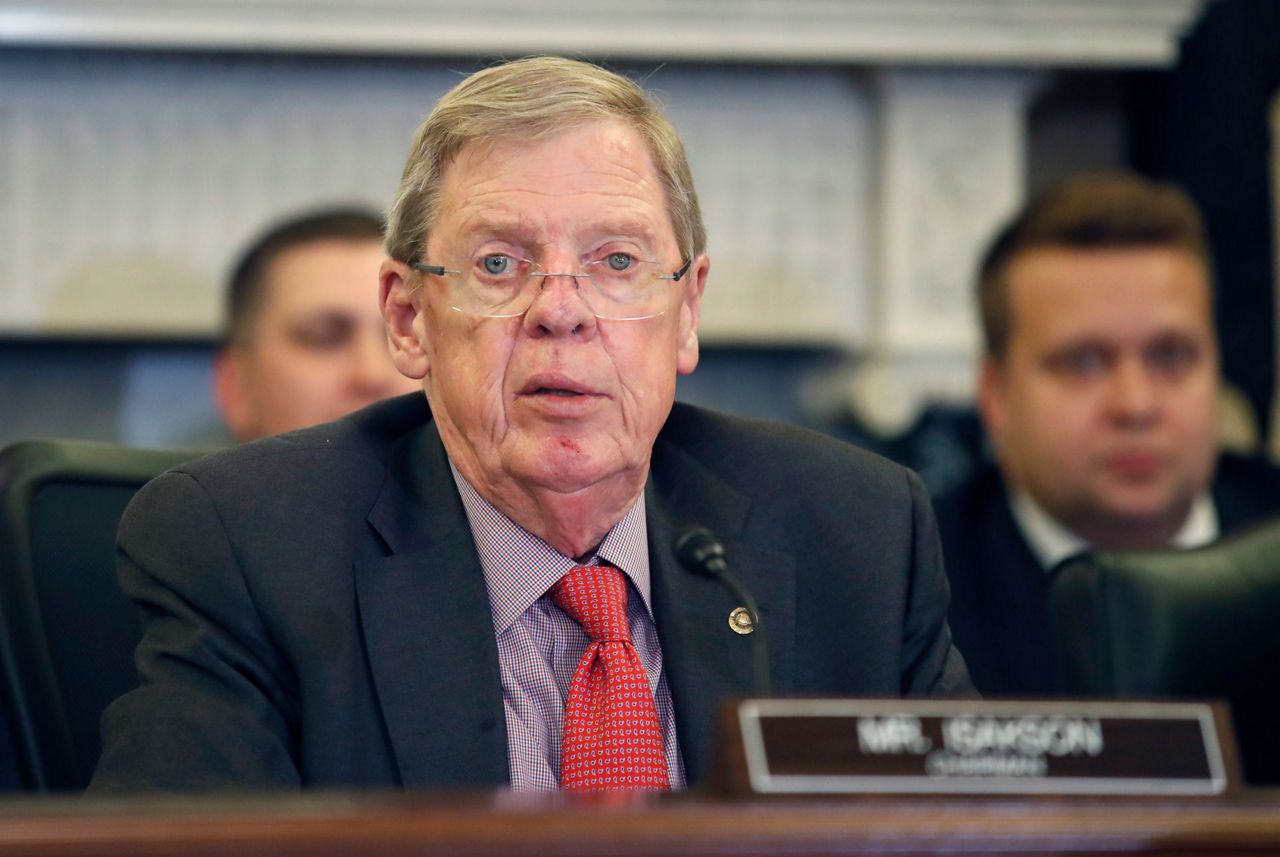DENVER (AP) — As Democrats try to win control of the White House and the Senate in 2020, they face a geographical puzzle — the path to the presidency may conflict with the one to a Senate majority.
Democrats' best shot at the White House is to win back their old turf — the Rust Belt states heavy with working-class white voters who have become increasingly difficult to hold in the party's tent. But the path to winning the Senate travels through what many believe is the Democrats' territory of the future. College-educated suburbanites, young people and minorities make up the winning coalition in Arizona, Colorado, Georgia and North Carolina, the states where Democrats will need to pick up seats to wrest control of the Senate from the GOP.
The tensions between the two contests — the two paths to two different victories — highlight the geographic concerns that have long bedeviled Democrats. The party has successfully built support in the growing West and Sun Belt states, but not yet enough to put the fight over the Rust Belt in the rearview mirror.
"They're kind of stuck between their past and their future," said William Frey, a demographer at the nonpartisan Brookings Institution in Washington, D.C. "It's an interesting conundrum."
For Democrats wrestling with picking their nominee, it's more than just a head-scratcher. Senate races and presidential races are linked — Senate candidates rarely win when their party's presidential candidate loses their state. If the party wants to win the White House and the Senate, its best hope of rolling back Republican gains under President Donald Trump, it will need to select a candidate who can win in both types of places.
"No question the Sun Belt will be central to the Democratic Party's success in 2020, far more than perhaps we understood even a few weeks ago," said Simon Rosenberg of NDN, a Democratic think tank that has long argued that demographics would help make the Sun Belt more hospitable for the party. "Winning in places like Arizona, Florida, Georgia and North Carolina is going to require us to stretch and reach and field a ticket that can win in these tough states, not just the traditional battlegrounds in the Rust Belt."
Although the dynamics of the presidential campaign are far from settled more than a year before Election Day, both parties are preparing to bear down on Wisconsin, Michigan and Pennsylvania, states that enabled Trump to win the White House while losing the popular vote in 2016. Democratic nominee Hillary Clinton was castigated for taking her eye off those states in the waning days of the 2016 contest and instead trying to rack up a bigger electoral victory by investing in Arizona and Georgia.
As a symbol of the importance of the Rust Belt troika this time around, the Democratic Party designated Milwaukee as the location of its convention next year where its nominee will be crowned. Front-runner Joe Biden launched his campaign in his birth state of Pennsylvania and based his campaign in Philadelphia, while other contenders from Sen. Bernie Sanders to Sen. Amy Klobuchar tout their ability to connect with Midwestern voters.
But those places aren't essential to Democrats' push to win control of the Senate.
Democrats must net at least three Senate seats to eke out a 50-50 tie should they win the White House. They're also bracing for a possible loss in Alabama, where Democrat Doug Jones won a 2017 special election that will be hard to replicate in a presidential year.
Democrats are eyeing several GOP-held seats in return. The two most vulnerable are in states Clinton won in 2016 — Colorado and Maine. After that, Democrats will have to bolster their numbers in Trump states. Although some hope to snag a seat in Iowa or even Kansas, the biggest trove of Senate seats lies where Democrats have been performing better in recent years like Arizona, North Carolina or Texas. Georgia became an especially big prize last week when Sen. Johnny Isakson announced he was retiring for health reasons, creating a second 2020 Senate election in the state along with Sen. David Perdue's reelection bid.
For years, Democrats have eyed these states as potentially friendly turf because of their demographic changes. But the timeline has been longer than some hoped, and high-profile losses in Georgia and Texas in 2018 were a reminder that the states remain difficult for the party.
The differences between the old and new battlegrounds are stark. The three Rust Belt states at the center of the presidential campaign are 76% white, according to U.S. Census data. Arizona, Georgia, North Carolina and Texas combined are only 49% white. Faster growing, they've attracted younger, and better educated, migrants from other parts of the country and enjoy booming economies, while the Rust Belt states are managing aging populations and declining industrial towns.
But, historically, whites in those growing Sun Belt states were far more likely to vote Republican than in the Rust Belt — a dynamic that offset their larger minority population and has kept them solidly in the GOP column. Despite incremental successes in the Sun Belt, Democrats still did far better in the Rust Belt states last year, dominating statewide elections in Pennsylvania and Michigan and narrowly winning top ones in Wisconsin.
"The easier path is going for the Rust Belt first," Frey said. "It's a unique candidate that could take both."
For example, Michigan Democrats rode to success partly on the pledge of their gubernatorial candidate Gretchen Whitmer to repair the state's perennially battered roads, an issue that would not resonate in the gleaming suburbs of Atlanta or Phoenix. Trade battles have ravaged Midwestern farmers but barely ruffled suburban Sun Belt professionals.
Still, the differences between these states may be eroding, notes Stephanie Valencia, a Washington, D.C.-based Democratic strategist. The Rust Belt states include fast-growing Hispanic populations. Support from Latino voters could both determine a close presidential race in Wisconsin and help Democrats win a Senate seat in Arizona.
"We need to be talking to voters everywhere, and doing so that racks up points on the margin," Valencia said. "There is a disproportionate amount of energy being focused on the Midwest and that part of the country, but I think people are realizing there are different iterations of the map."
One lesson from 2016, she added, is that Democrats can't put all their electoral eggs in one basket.
Copyright 2019 The Associated Press. All rights reserved. This material may not be published, broadcast, rewritten or redistributed.





